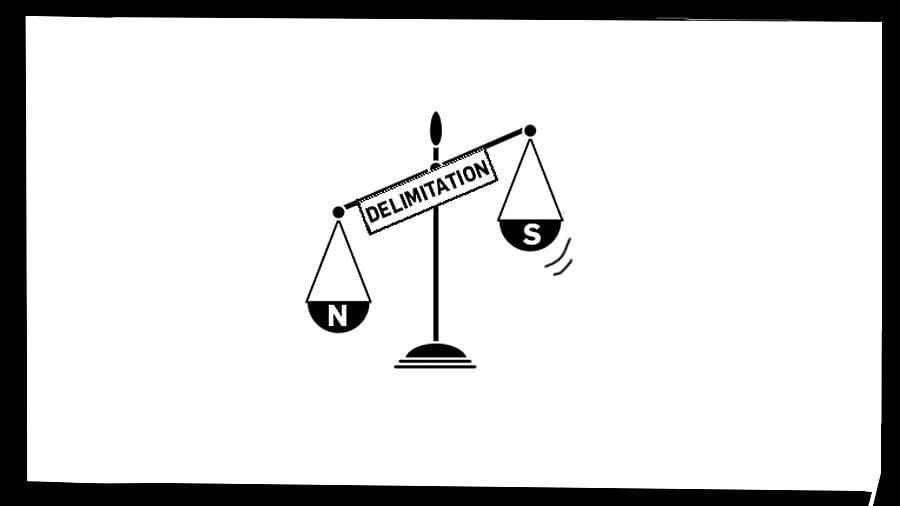Delimitation in India: Balancing Representation and Political Equity
Syllabus:
GS-2:
Indian Constitution , Elections , Statutory Bodies
Focus:
With the 2026 deadline for the delimitation freeze approaching, concerns have risen over political power shifts favoring northern states due to their higher population growth. The process raises debates on fair representation, federal balance, socio-economic disparities, and governance performance, making it a crucial electoral and constitutional issue.
Understanding Delimitation in India:
What is Delimitation?
- Delimitation is the process of redrawing parliamentary and assembly constituency boundaries based on population changes to ensure fair representation.
- It is conducted by an independent Delimitation Commission under Article 82 of the Indian Constitution.
Historical Background
- Delimitation has been carried out four times (1952, 1962, 1972, and 2002).
- The 42nd Constitutional Amendment (1976) froze the delimitation process to prevent states with controlled population growth from losing representation.
- The freeze was extended in 2001 until 2026.
Upcoming Delimitation (2029)
- With the 2026 deadline approaching, there are growing concerns about political power shifts due to demographic changes.
- Northern states (Uttar Pradesh, Bihar, Madhya Pradesh, etc.) are likely to gain more seats, while Southern states (Tamil Nadu, Kerala, etc.) might lose representation, raising concerns about fairness.
Constitutional Provisions on Delimitation:
- Article 82:
- Mandates that Parliament enacts a Delimitation Act after every Census.
- Based on this Act, a Delimitation Commission is constituted to redraw parliamentary and state assembly constituencies.
- Article 170:
- Specifies that States are divided into territorial constituencies as per the Delimitation Act after each Census.
- Ensures proportional representation based on population changes while maintaining federal balance.
- The 42nd and 84th Constitutional Amendments froze delimitation until 2026 to avoid penalizing states with successful population control measures.
Challenges of Delimitation:
North-South Population Imbalance
- Northern states have higher birth rates and larger populations, while Southern states have controlled population growth.
- This leads to malapportionment, where Southern states with better governance and economic indicators might lose parliamentary representation.
Socio-Economic Disparities
- Southern states contribute more to GDP, taxation, infrastructure, healthcare, and education.
- There is a concern that redistributing parliamentary seats based purely on population would penalize states with better development and reward those with high population growth.
Representation of Scheduled Castes (SCs) and Scheduled Tribes (STs)
- According to Article 330(2), SC/ST seat reservations should be proportional to their population in each state.
- Since the last seat allocation was based on the 2001 Census, many growing SC/ST communities remain underrepresented.
Women’s Representation
- The Women’s Reservation Bill (2023), which seeks one-third reservation in Parliament and state assemblies, is linked to delimitation.
- Since it will be implemented only after delimitation, meaningful gender representation is delayed until at least 2029.
Risk of Gerrymandering
- Delimitation can be manipulated for political gains by shaping constituencies to favor certain political parties or communities.
- This raises concerns about fair representation and political hegemony.
Legal and Constitutional Aspects:
Constitutional Provisions
- Article 82: Mandates periodic delimitation to ensure fair representation.
- Delimitation Act: Provides a legal framework for the Delimitation Commission to function independently.
- Judicial Review:
- The Meghraj Kothari vs. Delimitation Commission (1966) ruling upheld the finality of delimitation orders to avoid election delays.
- More recently, the Supreme Court dismissed a plea against Jammu & Kashmir’s delimitation, despite concerns about minority marginalization.
Global Comparisons
- New Zealand and South Africa have clear constitutional guidelines for delimitation.
- Japan and India manage the process through ordinary legislation.
- Other democracies ensure frequent revisions to reflect changing demographics fairly.
Proposed Solutions and Alternatives:
Expanding Lok Sabha Seats
- Political scientist Alistair McMillan suggests increasing total parliamentary seats instead of redistributing existing ones, ensuring no region loses representation.
- This could accommodate demographic changes without favoring certain states.
Reforming the Rajya Sabha
- Milan Vaishnav proposes empowering the Rajya Sabha to counterbalance North-heavy representation in the Lok Sabha.
- This would ensure Southern states maintain influence despite losing parliamentary seats.
Linking Delimitation to Decentralization
- More power should be devolved to states and local governments, reducing dependency on Parliamentary representation alone.
- This would empower regional governance, making state-level policies more effective.
Addressing Socio-Economic Disparities
- A comprehensive economic and governance performance index could be used alongside population data for seat allocation.
- States with better governance and lower fertility rates should receive incentives rather than penalties.
Ensuring Fair Representation for SCs, STs, and Women
- Updating SC/ST seat allocation based on recent Census data to reflect their actual population growth.
- Implementing Women’s Reservation Bill immediately, rather than waiting for delimitation.
The Way Forward:
Building Political Consensus
- A national-level discussion is necessary to ensure that delimitation does not become a North vs. South issue.
- Learning from the 127th Constitutional Amendment (2021), which had unprecedented political support, can help achieve consensus on delimitation.
Strengthening the Delimitation Commission
- Ensuring greater transparency in how boundaries are redrawn to avoid gerrymandering.
- Independent oversight and public participation should be integrated into the process.
Balancing Population and Governance Performance
- Moving towards a holistic approach where economic growth, governance, and human development indicators are factored into seat allocation.
Empowering Regional and Local Governance
- Strengthening state legislatures and local bodies so that power is more evenly distributed across different levels of government.
Periodic Reviews and Adjustments
- Rather than freezing delimitation for decades, a more frequent and balanced review process should be implemented, ensuring representation remains fair and up to date.
Conclusion:
Delimitation is crucial for ensuring fair representation, but its implementation must balance demographic changes with socio-economic realities. A population-only approach could disadvantage well-governed states, while political manipulation may lead to permanent power imbalances. By expanding parliamentary seats, decentralizing power, and ensuring fair representation for marginalized communities and women, India can strengthen its democratic fabric and ensure a more equitable electoral system.
Source: IE
Mains Practice Question :
Delimitation in India aims to ensure fair parliamentary representation, yet it poses challenges related to regional disparities, demographic shifts, and governance performance. Critically analyze the implications of the upcoming delimitation exercise and suggest reforms to maintain federal balance, equitable representation, and political stability in the Indian democratic system.




